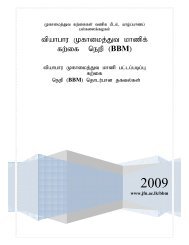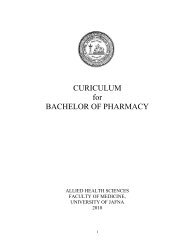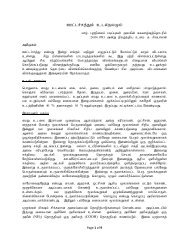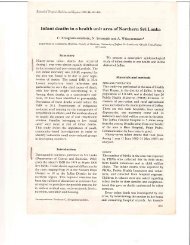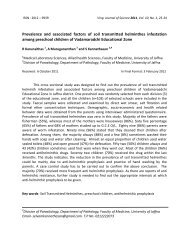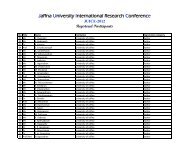MANUAL PHYSIOLOGY PRACTICAL - Repository:The Medical ...
MANUAL PHYSIOLOGY PRACTICAL - Repository:The Medical ...
MANUAL PHYSIOLOGY PRACTICAL - Repository:The Medical ...
You also want an ePaper? Increase the reach of your titles
YUMPU automatically turns print PDFs into web optimized ePapers that Google loves.
FM/UOJ<br />
Experiment 3<br />
TESTS FOR HEARING<br />
Hearing includes perception of sound waves in terms of pitch, amplitude and<br />
amber, higher functions such as recognizing and understanding the meaning of the words<br />
and the source of sound. This practical demonstrates the tests for perception of sounds<br />
only.<br />
<strong>The</strong> receptors are in the internal ear and different areas in the basilar membrane<br />
respond to different frequencies. When sound waves reach the ear, they vibrate the<br />
tympanic membrane, which is amplified by the ossicles and transmitted to the fluid in the<br />
inner ear where appropriate receptors are stimulated: air conduction. Any vibration that<br />
travels through the bones of the skull will also be transmitted to the bony covering of the<br />
inner ear and to the fluid in it and stimulate the receptors: bone conduction. When there is<br />
defect in the external or middle ear, the air conduction is defective but hearing is possible<br />
through bone conduction. In defects of inner ear, hearings by both conductions fail.<br />
Clinical Examination:<br />
A simple clinical examination for hearing is to cover one ear and speak to the<br />
subject from behind (to avoid lip-reading) in low voice. <strong>The</strong>n repeat the same for the<br />
other ear.<br />
Tuning fork test:<br />
Tuning forks of different frequencies are used to test the whole hearing range of<br />
frequencies. Two different types of tests are available to test for hearing loss and to<br />
differentiate the conduction deafness from nerve deafness.<br />
Rinne’s test:<br />
Strike a tuning fork and place its base on the mastoid process and ask the patient<br />
whether the sound is heard. If it is not heard, strike hard and repeat it. If it is not heard the<br />
subject is likely to have nerve deafness for that frequency. If it is heard hold it until the<br />
sound disappears. As soon as the subject indicates the disappearance of the sound hold<br />
the top of the tuning fork near the external auditory meatus. If the subject hears the sound,<br />
the ear is probably normal and if not the subject probably has conduction deafness.<br />
Repeat the test for that ear with tuning forks of varying frequencies to cover the audible<br />
range. <strong>The</strong>n test the other ear.<br />
Weber’s Test:<br />
Strike a tuning fork and place its base on the vertex or at the centre of the<br />
forehead. Ask the subject whether the sound is heard in both ears equally or which ear is<br />
louder. If both ears are similar the hearing is normal. If one ear is louder than the other,<br />
the louder ear may have conduction deafness or the other ear may have partial or<br />
complete nervous deafness.<br />
Neurology<br />
Page | 151




